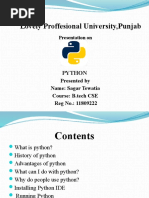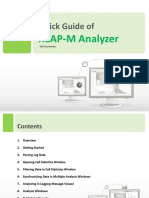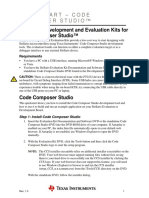Week 8 Developing the User Interface
Uploaded by
wvquirozWeek 8 Developing the User Interface
Uploaded by
wvquirozDeveloping the User Interface (UI) refers to the process of designing and creating the visual elements
of a software application that users interact with. The goal of UI development is to ensure that the
application is intuitive, easy to navigate, visually appealing, and functional, providing users with a
seamless experience. The UI acts as the bridge between the user and the underlying system or
application, allowing users to perform tasks, input data, view results, and navigate through different
features.
Key Aspects of UI Development:
1. Design: This involves creating the look and feel of the application. Designers focus on aspects
such as:
o Layout: How content is arranged on the screen (e.g., buttons, forms, navigation
menus).
o Typography: Choosing fonts that are legible and suit the tone of the application.
o Color Scheme: Selecting colors that reflect the brand and are visually comfortable.
o Iconography: Designing icons that represent actions like saving, deleting, and editing.
2. Usability: UI development emphasizes making the application easy to use. This includes:
o Intuitive Design: Ensuring users can easily understand and navigate the interface
without confusion.
o Responsive Design: Making sure the UI works well across different devices, screen
sizes, and orientations (e.g., mobile, tablet, desktop).
o User-Centered Design: Focusing on the needs, expectations, and behaviors of the
target users.
3. Interaction: UI is not just about static visuals; it also involves user interaction. Front-end
developers implement:
o Interactive Elements: Buttons, checkboxes, drop-down menus, sliders, etc.
o Feedback: Visual cues like highlighting buttons or showing loading indicators when a
user performs an action.
o Transitions and Animations: Smooth animations or transitions between states, such as
when moving from one screen to another or showing an alert.
4. Implementation: After designing the UI, developers implement the design using front-end
technologies like:
o HTML: Marking up the content structure of the interface.
o CSS: Styling the layout and design, ensuring it is visually appealing.
o JavaScript: Adding interactivity to the UI, such as handling user inputs and dynamic
updates.
5. Testing: Ensuring the interface works as intended through usability testing, including:
o User Testing: Observing real users interacting with the UI to identify pain points or
confusion.
o A/B Testing: Comparing two different UI designs to determine which performs better.
6. Iteration: Based on feedback and testing results, UI development often requires revisiting and
improving the design to make it even more user-friendly and effective.
Why is UI Development Important?
First Impressions: The UI is the first thing users interact with, and a clean, intuitive UI can
create a positive first impression of the product.
User Satisfaction: A well-designed UI leads to a better overall user experience, helping users
achieve their goals more efficiently.
Engagement: An aesthetically pleasing and functional UI encourages users to engage with the
product more frequently.
Accessibility: Ensuring that the UI is accessible to a diverse range of users, including those with
disabilities, is critical for inclusivity.
In summary, developing the user interface is a crucial step in creating software applications that are
not only functional but also easy to use and visually appealing. It involves both design and technical
skills, and it's an ongoing process of iteration and improvement based on user feedback.
Report Format: Developing the User Interface (UI)
1. Title Page
Report Title: Developing the User Interface
Author: [Your Name]
Date: [Date]
Course/Department: [Course Name / Department Name]
Organization: [Organization Name, if applicable]
2. Executive Summary
Purpose of the Report: A brief summary of the report, outlining the importance of UI
development in software and the key findings or conclusions.
Key Points: Overview of the development process, challenges, and best practices.
3. Table of Contents
List of Sections:
1. Introduction
2. Objectives of UI Development
3. UI Development Process
Requirement Gathering
Wireframing & Prototyping
UI Design
Front-End Development
Usability Testing
Iteration & Improvement
4. UI Design Principles
5. Tools for UI Development
6. Conclusion
7. Recommendations
Page Numbers: Include page numbers for easy reference.
4. Introduction
Overview: Introduction to the concept of User Interface (UI) development and its significance in
software development.
Scope: Explanation of the areas covered in the report, including UI design, tools, and best
practices.
5. Objectives of UI Development
User Engagement: Creating a UI that attracts and retains users.
Ease of Use: Ensuring the interface is intuitive and user-friendly.
Efficiency: Streamlining tasks and user actions.
Consistency: Maintaining design uniformity throughout the application.
Accessibility: Designing interfaces that are usable by all users, including those with disabilities.
6. UI Development Process
This section outlines the various stages involved in developing a user interface.
6.1. Requirement Gathering
User Research: Methods for understanding user needs (surveys, interviews).
Stakeholder Feedback: Collaborating with stakeholders to define UI requirements.
6.2. Wireframing & Prototyping
Wireframing: Low-fidelity sketches to plan UI layout and structure.
Prototyping: Creating interactive mockups to simulate user interaction.
6.3. UI Design
Visual Design Elements: Color scheme, typography, iconography, and layout.
Design Tools: Brief overview of the tools used to create high-fidelity UI designs.
6.4. Front-End Development
HTML/CSS/JavaScript: Front-end technologies for implementing the design.
Responsive Design: Ensuring the UI works across different devices (desktop, mobile, tablet).
Interactivity: Implementing features like buttons, forms, and transitions.
6.5. Usability Testing
User Testing: Observing real users interact with the UI to identify pain points.
Feedback Collection: Gathering input from users to refine the interface.
A/B Testing: Comparing versions to determine the most effective design.
6.6. Iteration & Improvement
Refinement Based on Feedback: Improving the design based on testing results.
Bug Fixes: Addressing usability or functional issues.
Optimizing Performance: Enhancing speed and responsiveness.
7. UI Design Principles
Discuss key principles to guide UI development:
Simplicity: Avoiding unnecessary elements and focusing on core functions.
Consistency: Uniformity in design and interaction patterns.
Feedback: Providing immediate feedback for user actions.
Error Prevention: Minimizing potential for user errors.
Affordance: Designing interactive elements that clearly suggest how they work.
8. Tools for UI Development
Design Tools: Figma, Sketch, Adobe XD, and InVision for wireframing, prototyping, and designing
high-fidelity UIs.
Front-End Frameworks: React, Angular, Vue.js for building dynamic interfaces.
UI Libraries: Material UI, Bootstrap for standardized design components and styles.
9. Conclusion
Summary: Recap of the key insights and importance of effective UI development.
Impact on User Experience: How UI design directly influences the user experience and the
success of a product.
10. Recommendations
User-Centered Design: Focus on understanding and prioritizing user needs.
Testing and Iteration: Regularly test the UI and refine based on user feedback.
Accessibility and Inclusivity: Ensure that the UI is accessible to all users, including those with
disabilities.
Tool Selection: Choose the best tools for design and front-end development to improve
efficiency and quality.
11. References
Citations: List of books, articles, and online resources referenced in the report.
Format: Follow a consistent citation style (APA, MLA, etc.).
12. Appendices (if applicable)
Supplementary Information: Additional charts, graphs, or UI design examples that support the
report.
This format offers a structured approach to documenting the development process for creating a user
interface, from initial planning to testing and iteration.
You might also like
- User Interface Design Process & Basic Design IssuesNo ratings yetUser Interface Design Process & Basic Design Issues14 pages
- ShivamIsrani - 23 - UI-Lab - Practical 1No ratings yetShivamIsrani - 23 - UI-Lab - Practical 15 pages
- Get Started Developing UI for Windows AppsNo ratings yetGet Started Developing UI for Windows Apps66 pages
- The Main Differences Between UX and UI AreNo ratings yetThe Main Differences Between UX and UI Are5 pages
- Ccs370-Ui &ux Design-Lecture 1-Ui and Ux Introduction 30.01.2024No ratings yetCcs370-Ui &ux Design-Lecture 1-Ui and Ux Introduction 30.01.202449 pages
- Software Enterpunership.pptx lecture 9&10No ratings yetSoftware Enterpunership.pptx lecture 9&1013 pages
- Mobile Computing Lectures 3 - ITU08215 - 034502No ratings yetMobile Computing Lectures 3 - ITU08215 - 03450220 pages
- How to Learn Digital Marketing from Scratch and Alone - Volume 09: UX and UI Design: Improving the User ExperienceFrom EverandHow to Learn Digital Marketing from Scratch and Alone - Volume 09: UX and UI Design: Improving the User ExperienceNo ratings yet
- PHP Developer Software Engineer in Houston TX Resume Richard WykeNo ratings yetPHP Developer Software Engineer in Houston TX Resume Richard Wyke2 pages
- Piktochart e Book 2 Create Your First Infographic in 15 MinutesNo ratings yetPiktochart e Book 2 Create Your First Infographic in 15 Minutes15 pages
- MiCam - Debug - 2024 05 16 21 11 51 897212No ratings yetMiCam - Debug - 2024 05 16 21 11 51 89721268 pages
- Oracle 12cR2 Installation On Linux With ASMNo ratings yetOracle 12cR2 Installation On Linux With ASM40 pages
- Installing Wilcom EmbroideryStudio On A MacNo ratings yetInstalling Wilcom EmbroideryStudio On A Mac8 pages
- S e 2019 Pattern Insem Exam Timetable For March April 2024 1 1No ratings yetS e 2019 Pattern Insem Exam Timetable For March April 2024 1 111 pages
- User Interface Design Process & Basic Design IssuesUser Interface Design Process & Basic Design Issues
- Ccs370-Ui &ux Design-Lecture 1-Ui and Ux Introduction 30.01.2024Ccs370-Ui &ux Design-Lecture 1-Ui and Ux Introduction 30.01.2024
- How to Learn Digital Marketing from Scratch and Alone - Volume 09: UX and UI Design: Improving the User ExperienceFrom EverandHow to Learn Digital Marketing from Scratch and Alone - Volume 09: UX and UI Design: Improving the User Experience
- PHP Developer Software Engineer in Houston TX Resume Richard WykePHP Developer Software Engineer in Houston TX Resume Richard Wyke
- Piktochart e Book 2 Create Your First Infographic in 15 MinutesPiktochart e Book 2 Create Your First Infographic in 15 Minutes
- S e 2019 Pattern Insem Exam Timetable For March April 2024 1 1S e 2019 Pattern Insem Exam Timetable For March April 2024 1 1

























































































